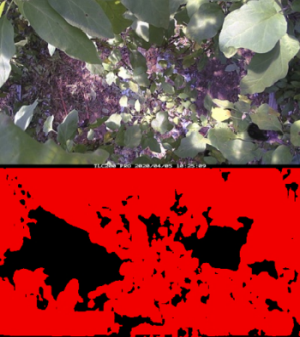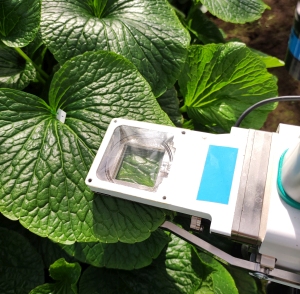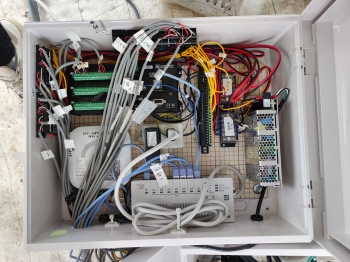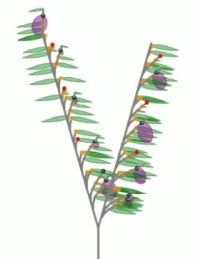Kochi University
Faculty of Agriculture and Marine Sciences / IoP Collaborative Creation Center
Laboratory of Environmental Control
for Crop Production
高知大学 農林海洋科学部 / IoP共創センター
作物環境調節学研究室
研究方針
Research Statement
本研究室では、「作物の環境応答を理解し、より良い作物生産に貢献すること」を目標にしています。
Our laboratory tries to understand crop responses to the surrounding environment and eventually to contribute to better crop production.
研究の柱は、「計測」と「解析」です。
「計測」にあたっては、実際の露地・施設園芸の栽培現場における環境要素、作物成長、収量などを、様々な装置や手法を駆使して計測します。
一口に「計測」と言っても、生物に由来する「ランダム性」や、個々の栽培現場特有の「個別事情」などのせいで、様々な難しさに直面します。
良い計測結果を得るためには、綿密な実験計画と、様々な工夫とが必要になってきます。また得られたデータを統計的に解析することも、「計測」における重要な要素です。
「解析」は、作物の生理・生態に関する様々な理論を利用・拡張し、数値シミュレーション等も応用しながら、
「計測」だけでは得られない普遍的な結論を導く作業です。理論に精通することはもちろん、プログラミング技術に習熟することが重要になってきます。
The research topics of our laboratory are broadly categorized into "measurement" and "analysis."
In the "measurement" part, we try to measure crop-environment interactions more accurately and easily than before.
In the "analysis" part, we try to extend existing theories about crop ecophysiology and apply them to simulation studies.
研究テーマ
Research topics
画像を用いた作物計測
Measurements of crop behivor using imaging sensors

定点カメラやスマートフォンなどの画像を用いて、作物の成長や環境応答などを計測しています。 コンピュータビジョンの目覚ましい発展により、作物個体群の葉面積指数(LAI)や、果菜類の開花数・着果数などの情報を抽出することが可能になりつつあります。 これらの技術は、将来的には、作物の成長モニタリングや収量予測などへの応用が期待されています。 他方、作物の不均一性・ランダム性による計測誤差や、現場でのカメラの設置方法などに、研究上の課題(研究の余地)が残っています。
We use computer vision technologies to extract crop information such as the leaf area index (LAI) and the numbers of flowers and fruits. These kinds of information can be used for e.g., the monitoring of crop status and the prediction of crop yields. Several difficulties still exist in accurately measuring crop properties, as a crop canopy is highly non-uniform.
個葉・個体群のガス交換計測
Gas exchange measurement of leaves and canopies

作物は、葉表面で、光合成と蒸散とを行っています。
これらの反応は「ガス交換」と呼ばれています(大気中のCO2と、葉内のH2Oとを交換しているように見えることから)。
個葉スケールでのガス交換は、専用の装置で葉を囲って、CO2やH2Oの濃度変化を調べることによって、計測可能です(右写真)。
また、作物個体群のスケールでのガス交換も、自作装置によって計測しています。
これらの計測結果から、個葉や個体群スケールでの様々な生理生態機能を推定することが可能です。
Crops perform photosynthesis and transpiration on the leaf surface. Together, these physiological functions are called the leaf gas exchange. The rate of the leaf gas exchange can be measured by measuring change in CO2 and H2O gas concentrations at the leaf using a device as in the photograph. The rate of the gas exchange in a canopy scale can also be measured using a large transparent chamber enclosing the crop canopy. Based on these measurements, we can estimate various crop ecophysiological properties.
土壌物理性と作物成長との関係解析
Analysis of relationships between soil physical properties and crop growth

土壌の保水性や透水性、硬さといった性質は、作物の生育に重大な影響を及ぼします。 これらの性質は、土壌ごとに異なるので、土壌の性質を踏まえて、 管理の仕方(例:かん水量やタイミング)を決定する必要があります。 また、どのような土壌物理性を持つ土が「良い土」であるのか、 「良い土」に近づけるためには栽培現場で何をすべきか、など、 簡単には答えられない疑問が残っています。 私たちは、自作のかん水装置などを駆使して、実験・理論の両面から、 これらの課題に取り組んでいます。
Soil physical properties, such as water retentivity, conductance, and hardness, can influence crop growth.
These properties can differ among soil types and depending on field conditions,
and in order to maximize crop production, we need to adjust our crop management (e.g., irrigation dose and timings)
to these soil physical properties.
We investigate relationships among soil physical properties, crop management, and crop growth based on experiments.
作物個体群内の光透過・ガス交換のシミュレーション
Simulation of canopy-scale radiation transfer and gas exchange

作物個体群内の光透過やガス交換速度を、コンピューター上で再現する研究を行っています。
シミュレーションでは、光、温度、湿度、CO2濃度など、栽培現場で計測可能な項目をシミュレーションの「入力」とすることで、
個体群スケールでの光合成速度や蒸散速度といった、栽培に有益な情報を「出力」することができます。
これにより、「どのような環境・作物状態のときに、個体群の光合成を最大化できるか」、
「ある環境・作物状態のときに、個体群の蒸散速度がどのくらいだから、どのくらいのかん水を行えば良さそうか」、
などについて、検討することが可能になります。
一方、作物個体群の3次元情報を栽培現場で計測する方法や、それらをコンピューター上で表現する方法などに、
まだ研究の余地が多く残されており、面白い研究テーマの一つです。
We try to simulate the canopy-scale gas exchange in the computer. Using the simulator, we can estimate the canopy-scale photosynthetic rate and transpiration rate from climatic data (e.g., solar radiation, temperature, CO2 concentration, and humidity). The simulation results can be used for e.g., optimizing greenhouse climatic conditions to maximize the canopy-scale photosynthetic rate.
作物の成長シミュレーション
Simulation of crop growth

作物の成長をコンピュータ上で再現する研究を行っています。 作物は、光合成で合成した炭水化物を利用して成長してきます。 従って、光合成で合成した炭水化物の使途を、うまく数式で記述できれば、 作物の成長の仕方を、ある程度、コンピュータ上で再現できると考えています。 作物の各器官に、どのくらい炭水化物が分配されて、そこでどのように使用されるか、 についてデータを蓄積するとともに、データを基に、作物の成長を再現できるような数式やパラメータを検討しています。
Crops grow using carbohydrates produced by photosynthesis. We try to find equations that describe this growth process. Respiration, translocation, and storage of the synthesized carbohydrates are key processes to understanding crop growth. We are collecting data on these fundamental processes through laboratory experiments. Combining all the available information, we construct a simulation model that reproduces actual crop growth.